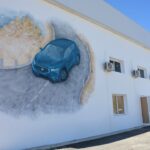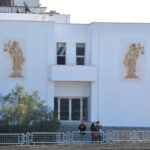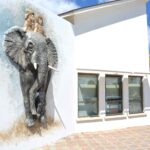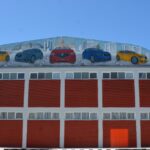
The walls on the Near East University campus are literally speaking with three-dimensional reliefs made by Uzbek artist Alovuddin Ashrapov. The final relief, completed in six months of labor, also draws attention with its giant size of 145 square meters.
The Near East University campus has an atmosphere colored by culture and art with its museums, open-air sculptures and nearly 500 exhibitions, and now the walls are coming to life with art! The three-dimensional relief works, which allow art to intertwine with architecture, add an aesthetic touch to the buildings and provide visitors and students with an open-air museum experience. The reliefs, made by Uzbek artist Alovuddin Ashrapov, are currently located at four points on the campus.
In reliefs, which are a three-dimensional art form, the artists aim to create a lively effect with light and shadow plays. These works of art with depth have a three-dimensional effect that changes according to the viewer’s perspective. Artist Alovuddin Ashrapov’s relief works on the Near East University campus not only create visual richness, but also carry meanings that are appropriate to the identity of the areas they are located in. Ashrapov continues to work on his new reliefs that strengthen the campus as a living, thinking and inspiring art center.
A 145-square-meter giant relief fascinates visitors!
Alovuddin Ashrapov has created a unique work that reflects the identity of the Near East University in the giant reliefs he completed in six months of labor on the exterior of the Near East College Sports Hall. The 100 percent electric GÜNSEL, which reveals the country’s technological development capacity, takes the lead role in the reliefs that are 29 meters wide and 5 meters high. The relief, in which the five vehicles of GÜNSEL’s first model B9 are in the foreground, includes GÜNSEL Production Facilities, Cyprus Museum of Modern Art, Near East University Hospital, the faculties of Medicine, Health Sciences, Pharmacy and Dentistry, and Dr. Suat Günsel Mosque in the background. Another relief work depicting GÜNSEL is located right behind the event area on the campus.
Justice and Innocence!
Another relief on the campus adorns the walls of the Near East University Faculty of Law building. The two female figures holding scales, which strongly express the universal principles of the concept of law, emphasize the balance and impartiality of justice while also reminding us of the balancing role of law on society. The reliefs, which are 4 meters high and 2 meters wide, also provide significant inspiration for law faculty students.
In the Near East Preschool building, there is a special design consisting of a giant elephant figure and two children, one girl and one boy. The depictions on the relief are symbolizing innocence and wisdom, the elephant figure also represents family unity and loyalty. This artwork, which emphasizes that education is not only an academic process but also a process that supports emotional and cultural development, draws attention with its 3-meter width and 5-meter height.
Who is Alovuddin Ashrapov?
Alovuddin Ashrapov was born in Tashkent, Uzbekistan in 1969. After completing his high school education, he graduated from the Wood Carving Department of the Republic Art School with honors. Ashrapov, who successfully brings together the natural energy and delicate details in his art, quickly became a well-known master by attracting attention with his unique style. His artistic competence has also been appreciated in different countries such as Kazakhstan, United Kingdom, the United Arab Emirates and the Russian Federation. Alovuddin Ashrapov, whose artworks are exhibited in the Cyprus Museum of Modern Art, uses materials such as carcass, sand, white cement, acrylic paint and varnish as the basis for his relief works. The artist continues to skillfully blend these materials with a unique narrative language in each of his works.




